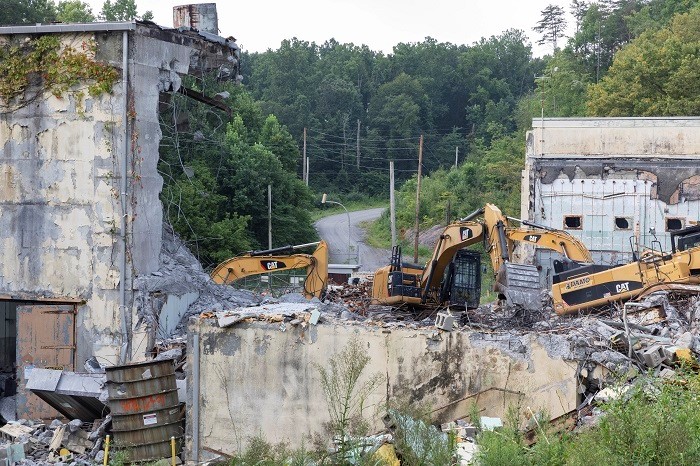A view of the Savannah River Site’s H Area. (Photo: DOE)
The Department of Energy’s Office of Environmental Management (EM) announced on October 18 that it has begun the process of transferring primary authority of South Carolina’s Savannah River Site (SRS) to the National Nuclear Security Administration, with the transfer expected to be completed in 2025.
DRUM program members and others visit mine sites in the Navajo Nation during the spring of 2022. (Photo: DOE-LM)
The Department of Energy’ Office of Legacy Management (LM) will be conducting verification and validation work at abandoned uranium mines in the Navajo Nation of northeastern Arizona during the fall field season, which runs from mid-October to mid-December.
A screenshot from a 3D animation showing the heat-up of Hanford’s melters. (Image: DOE)
Crews at the Department of Energy’s Hanford Site, near Richland, Wash., have begun heating up the first of two 300-ton melters that will be used to vitrify mixed low-level radioactive and chemical tank waste. According to the DOE’s Office of Environmental Management (EM), initiating and completing the heating of the melter is a critical step to commissioning Hanford’s Waste Treatment and Immobilization Plant (WTP), which will treat and stabilize the site’s 56 million gallons of tank waste by immobilizing it in glass through the vitrification process.
Crews make progress tearing down the former Criticality Experiment Laboratory. The teardown began this past summer after months of deactivation activities. (Photo: DOE)
Work crews at the Department of Energy’s Oak Ridge Site in Tennessee have successfully completed the demolition of the former Criticality Experiment Laboratory. Crews worked this past summer to bring down the dilapidated 1940s-era facility, also known as Building 9213.
The Savannah River Site (Photo: DOE)
The Department of Energy has extended Savannah River Nuclear Solutions’ (SRNS) management and operating contract at the Savannah River Site (SRS) in South Carolina for up to an additional five years. The announcement was made recently 29 by engineering company Fluor, which leads the SRNS joint venture, along with Newport News Nuclear and Honeywell.
DRUM team members at the Telluride 18 mine in the Yellow Cat area of southwest Colorado.
Based on a review of U.S. Atomic Energy Commission (AEC) records and available data from numerous agencies, there are an estimated 4,225 mines across the country that provided uranium ore to the U.S. government for defense-related purposes between 1947 and 1970. To aid in the cleanup of these legacy uranium mines and establish a record of their locations and current conditions, the Defense-Related Uranium Mines (DRUM) program was established within the Department of Energy’s Office of Legacy Management (LM).
Demolition of the MPPB, one of the last remaining major facilities at WVDP, is expected to be completed in about 30 months. (Photo: DOE)
The Department of Energy’s Office of Environmental Management (EM) said it has met one of its cleanup priorities for 2022 by beginning demolition of the Main Plant Process Building (MPPB) at the West Valley Demonstration Project (WVDP) in New York. Located 35 miles south of Buffalo, the 150-acre WVDP site is home to the only commercial spent nuclear fuel reprocessing facility to operate in the United States.
The Effluent Management Facility, part of the Waste Treatment and Immobilization Plant at the Hanford Site. (Photo: Bechtel National)
This spring, the U.S. Government Accountability Office (GAO) released an insightful report reviewing and summarizing the status and performance of the largest projects and operations within the Department of Energy’s Office of Environmental Management (EM), which is responsible for the cleanup of hazardous and radioactive waste at sites and facilities that have been contaminated from decades of nuclear weapons production and nuclear energy research.
Spain’s nuclear power plants are to use Holtec’s HI-STORM spent fuel storage technology. (Image: Holtec)
Holtec International announced that its flagship HI-STORM Multi-Purpose Canister (MPC) spent fuel storage technology was selected by Spain’s national company Enresa for a fleet of six nuclear power reactors at four plant sites in the country. Equipos Nucleares S.A. (ENSA), a Cantabria-based manufacturer of equipment for the Spanish nuclear fleet, was named a consortium partner with Holtec in the order, which was conducted under European Union procurement rules.
Demolition has begun on the Bulk Shielding Reactor at the Oak Ridge National Laboratory. It marks the first teardown of a former reactor at the site. (Photo: DOE).
In a first for the Department of Energy’s Oak Ridge Site, a former reactor facility is being demolished. The site’s cleanup contractor, UCOR, began tearing down the Bulk Shielding Reactor, also known as Building 3010, last week.
“While this project is not the biggest demolition we’ve undertaken, it carries a lot of significance,” said Laura Wilkerson, acting manager for the Oak Ridge Office of the DOE’s Office of Environmental Management (EM). “It is the first removal of a former reactor at [Oak Ridge National Laboratory], and it is a signal of much more to come at the site in the immediate future.”
An illustration of Switzerland’s proposed deep geological repository. (Image: Nagra)
Nagra, Switzerland’s national cooperative for the disposal of radioactive waste, has announced that it has selected Nördlich Lägern as the site for a deep geological repository for radioactive waste. According to Nagra, extensive investigations have shown that Nördlich Lägern, located in northern Switzerland near the German border, is the most suitable area for a geologic repository with the best overall safety reserves.
The Palisades nuclear power plant.
The Nuclear Regulatory Commission has made Holtec International’s post-shutdown decommissioning activities report (PSDAR) for the closed Palisades nuclear power plant available for public comment until December 27. The NRC also plans to hold a public meeting to discuss the report on the evening of September 22 at the South Haven campus of Lake Michigan College, about 10 miles north of the Palisades site in Covert, Mich.
Retention basins at the Liquid Effluent Retention Facility on the Hanford Site, as seen in September 2021, at top, and recently with the nearly completed Basin 41 on the far left. (Photo: DOE)
Work is nearing completion on a fourth basin needed to ensure adequate storage for wastewater during tank waste treatment on the Department of Energy’s Hanford Site, in Washington state.
According to the DOE, its operations contractor Washington River Protection Solutions (WRPS) has made significant progress on Basin 41 at the Liquid Effluent Retention Facility (LERF) since concrete was first poured for the perimeter one year ago.
Video: Watch this time-lapse video of the LERF Basin 41 construction.










 The Department of Energy’s Office of Environmental Management (EM) released its
The Department of Energy’s Office of Environmental Management (EM) released its 






